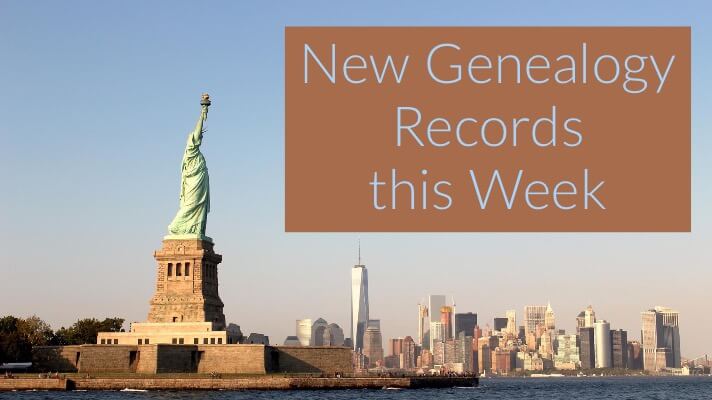by Lisa Cooke | Jun 3, 2016 | 01 What's New, Records & databases
Here are this week’s fabulous list of new genealogy records online. Included are records for Australia, Great Britain, United States, and the Philippines.
AUSTRALIA – REGISTER OF INMATES. The Ballarat Benevolent Society Register of Inmates for 1860-1897 is an ongoing project by Brett Weinberg. This register is a transcription and can be viewed on the Ballarat Historical Society website. The list of inmates from the Ballarat Benevolent Asylum in Victoria, Australia are in alphabetical order. The index provides details of age, birth place, parents names, residence, arrival date in Victoria and any additional remarks.
GREAT BRITAIN – MILITARY. The British Royal Navy & Royal Marines Service and Pension Records 1704-1919 are available at Findmypast. These records include the original service and pension records of those serving in the British Royal Navy and Marines. Information may include name, discharge date, death date, next of kin, and parish.
UNITED STATES – IOWA – MILITARY. Membership records of the Department of Iowa Grand Army of the Republic are now free to search on FamilySearch.org. The records are arranged by county and then by posts within each county. The records include veteran’s name, residence, occupation, date and place of birth, date and place of death, cemetery where buried, war record, dates of enlistment and discharge, names of parents, spouse, and children (if given.)
PHILIPPINES – MANILA – CIVIL REGISTRATION. The Manila Philippines Civil Registration for 1899-1984 at FamilySearch.org includes images of births, marriages, and deaths. This collection is only partially indexed at this time and currently covers birth certificates between the years of 1900 to 1980.
UNITED STATES – INDIANA – BIRTH, DEATH, AND MARRIAGES. Three new databases for Indiana have been recently added to Ancestry. They are Indiana, Birth Certificates, 1907-1940; Indiana, Marriage Certificates, 1958-2005; and Indiana, Death Certificates, 1899-2011. Each database offers digital images of these certificates and are jam packed with great genealogy data for your family tree!
 Thank you for sharing this list with your favorite genealogy gurus! We love sharing good news about new genealogy records online.
Thank you for sharing this list with your favorite genealogy gurus! We love sharing good news about new genealogy records online.
by Lisa Cooke | Apr 1, 2014 | 01 What's New, Beginner, Family History Podcast

Listen to the Family History: Genealogy Made Easy podcast by Lisa Louise Cooke. It’s a great series for learning the research ropes and well as refreshing your skills.
Family History: Genealogy Made Easy
with Lisa Louise Cooke
Republished April 1, 2014
[display_podcast]
Download the Show Notes for this Episode
Welcome to this step-by-step series for beginning genealogists—and more experienced ones who want to brush up or learn something new. I first ran this series in 2008-09. So many people have asked about it, I’m bringing it back in weekly segments.
Episode 25: Using Civil Birth Records in Family History
In our last episode we covered marriage records. We finish up vital records in this episode by going back to the beginning: birth records.
There are two major categories: civil and church records. Today I’m bringing in professional genealogist Arlene H. Eakle, PhD, who will helps us to see the challenges we face and the success we can have locating civil birth records. (In Episode 26, Arlene will join me again to walk us through the world of church birth records.)
Here are some take-away tips from our discussion in this episode:
- When you start researching in a new area, learn when government birth records began to be kept. Every state and some cities began birth registration at different times. Today, in some states you order records before a certain date from the local government and more recent ones from the state vital records office. Do your research! Start with this Vital Records Chart from Family Tree Magazine.
- In the U.S., most government birth records were kept by the county, except in New England and independent cities. In the 20th century, the state took buy medication cart over jurisdiction of vital records in most states.
- Birth records often have the names of parents and child and the place and date of birth. You may also find parents’ birthplaces, marital status of parents and even the date of marriage.
- A single locale may have logged births in multiple sources, for example, for those who lived in or outside the city limits, or segregated records for blacks.
- The actual birth record may have been logged as part of a list of names on a columned form. Birth certificates are a modern thing!
- Some records have been digitized and indexed or microfilmed. Check the Family History Library catalog on FamilySearch.org first. If they have birth records, they’ll tell you whether they’ve been digitized or indexed on their site, or whether they’re available on microfilm.
- Of course, many birth records are also available on subscription websites like Ancestry.com, FindMyPast.com, MyHeritage.com and more. If you are a subscriber, check their online holdings, too.
- When ordering a birth record from a government office, they may type up a certificate to send you. That’s nice, but also ask for a photocopy of the original birth entry or record. There’s often more on the original record than the certificate—and you’ll minimize errors by looking at the real record.
Arlene H. Eakle, Ph.D., is the president and founder of The Genealogical Institute, Inc. and a professional genealogist since 1962. She holds both MA and Ph.D. in English History and an Associate degree in Nursing.

 Thank you for sharing this list with your favorite genealogy gurus! We love sharing good news about new genealogy records online.
Thank you for sharing this list with your favorite genealogy gurus! We love sharing good news about new genealogy records online.




